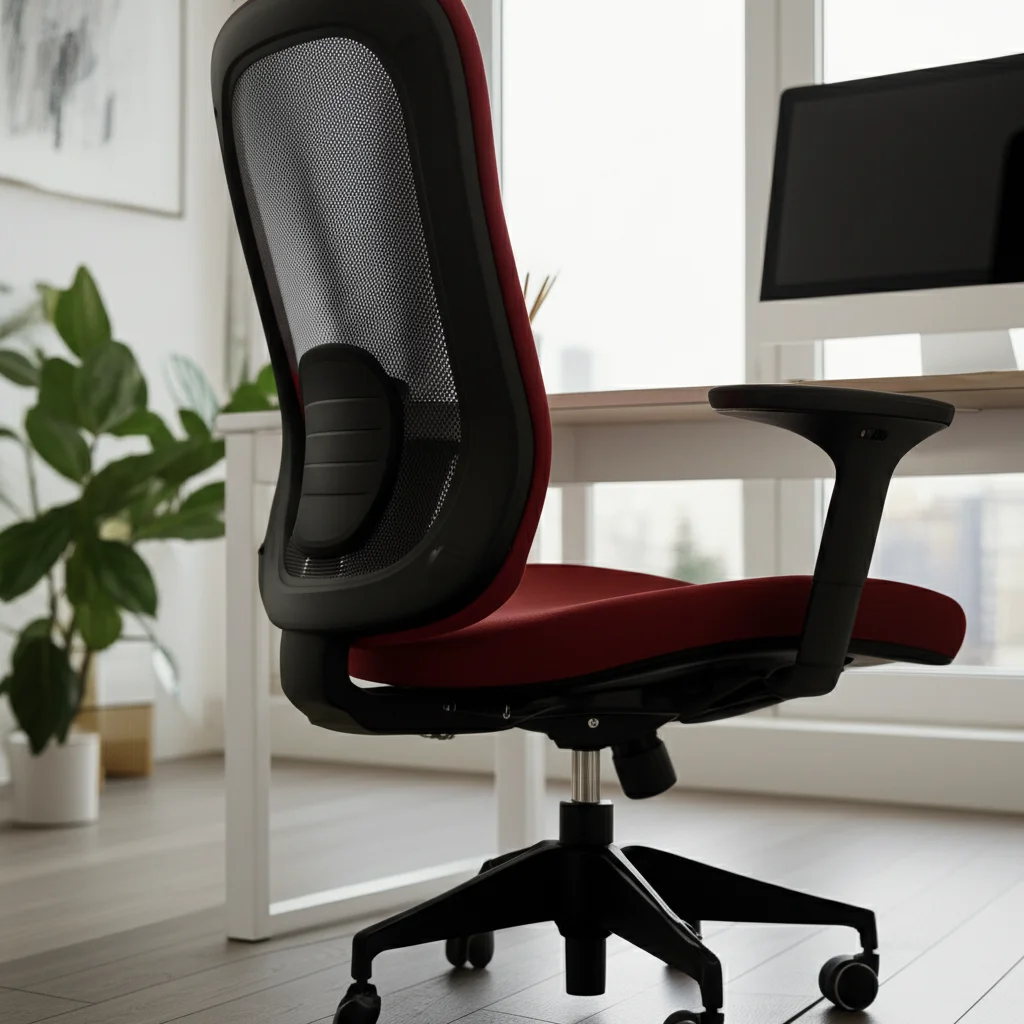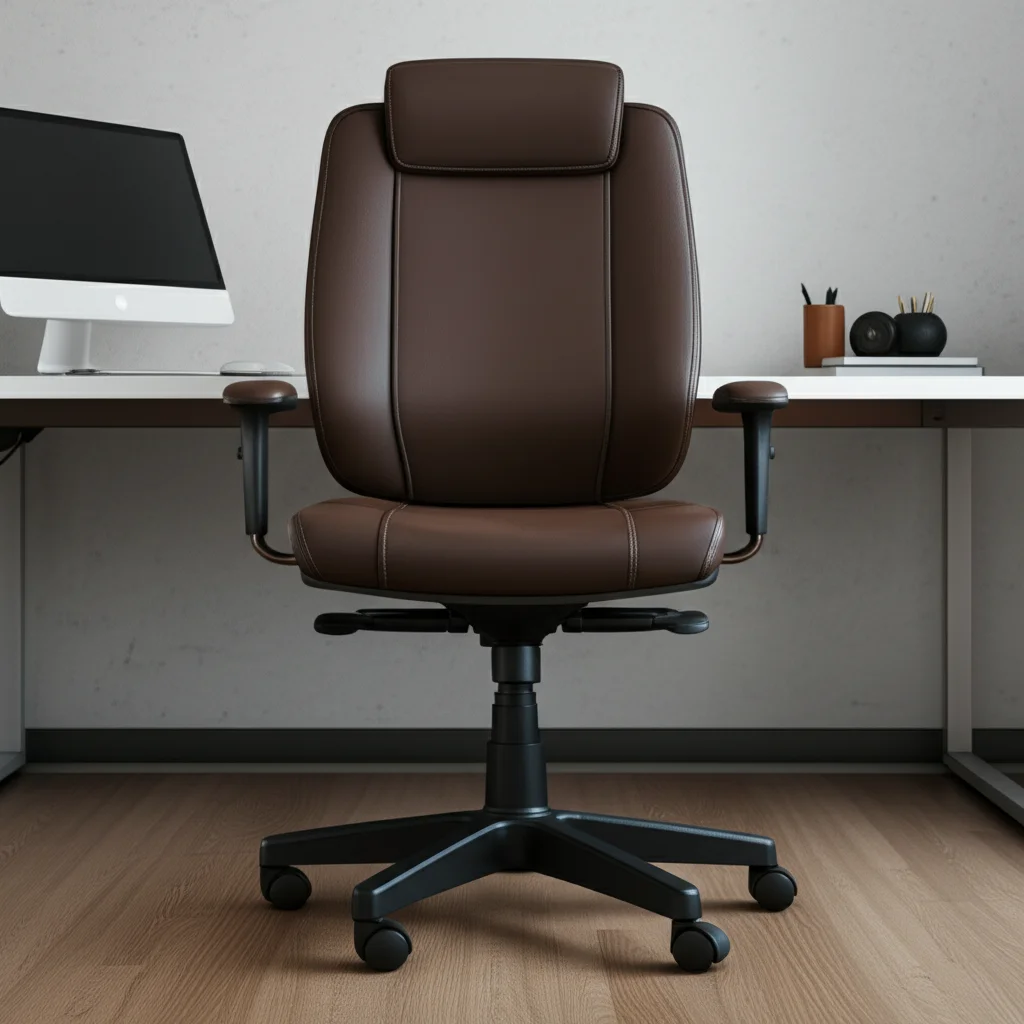· Todd Martin · Ergonomics & Comfort · 19 min read
How To Position Lumbar Support On Chair

How To Position Lumbar Support For Ultimate Chair Comfort
Sitting for many hours can take a toll on your back. Many of us spend a large part of our day in a chair, whether for work or leisure. Proper support is key to avoiding discomfort. I want to help you understand exactly how to position lumbar support on chair to prevent back pain and improve your posture. This guide will walk you through everything, from identifying your natural spinal curve to fine-tuning your chair for peak comfort.
Poor posture leads to chronic back pain. Lumbar support keeps your spine in its natural, healthy curve. You can improve your overall well-being by learning correct positioning. We will cover why lumbar support matters, different types of support, and a step-by-step adjustment guide. I will also share common mistakes to avoid and tips for integrating support into your full ergonomic setup. Let’s make your chair a place of comfort, not pain.
Takeaway:
- Identify your natural lumbar curve for accurate support placement.
- Position support directly into the inward curve of your lower back.
- Adjust support height and depth for firm, comfortable pressure.
- Combine lumbar support with other chair adjustments for full ergonomic benefits.
To position lumbar support on your chair, place the support firmly into the inward curve of your lower back. This area, just above your waistline, needs support to maintain your spine’s natural S-shape. Adjust the height and depth of the support until it feels comfortable and your back is aligned.
The Importance of Proper Lumbar Support Positioning
Supporting your lower back is crucial for good health. Your spine has a natural S-shape curve, and the lower part, called the lumbar region, curves inward. When you sit without proper support, this natural curve can flatten or even round outward. This puts stress on your spinal discs and muscles. This stress often leads to discomfort and pain.
Proper lumbar support keeps this natural curve in place. It helps distribute your body weight evenly. This reduces pressure on specific points in your lower back. It also encourages better posture throughout your entire spine. When your lower back is supported, your shoulders naturally relax, and your head aligns properly over your neck.
Understanding Lumbar Support
Lumbar support refers to any cushion or built-in mechanism that supports the inward curve of your lower back. This support fills the gap between your lower back and the chair backrest. It helps prevent slouching. It also reduces the tendency to lean forward excessively. Think of it as a gentle hand holding your spine in its ideal position.
Different chairs offer different types of lumbar support. Some office chairs have adjustable built-in mechanisms. Others require adding an external cushion. The goal for all types remains the same. The support must meet your individual spinal needs. It should feel like an extension of your back, not a rigid block.
Benefits of Correct Positioning
Correctly positioning your lumbar support offers many benefits. First, it significantly reduces the risk of lower back pain. Many people experience relief once they set up their support properly. Second, it promotes healthier posture. Good posture impacts your breathing, digestion, and energy levels. You will stand taller and feel more confident.
Third, correct support increases comfort and focus during long sitting periods. When you are comfortable, you can concentrate better on tasks. This improves productivity at work or home. Finally, it helps prevent long-term spinal issues. Investing time in proper chair setup protects your spinal health for years to come. It truly makes a difference in daily life.
Types of Lumbar Support Systems
Chairs come with various lumbar support options. Understanding these types helps you choose the best solution for your needs. Some chairs have built-in features. Other chairs need added accessories. Each system aims to provide relief and maintain proper spinal alignment. My goal is for you to identify what works best for you.
You might have an advanced ergonomic chair or a simple dining chair. There’s a support solution for almost every seating situation. Knowing the differences helps you make smart choices. It also ensures you can properly adjust what you have. Let’s explore the common types you will encounter.
Built-in Adjustable Lumbar Support
Many modern office chairs feature built-in adjustable lumbar support. These systems allow you to modify the support’s height, depth, or firmness. You might find a knob on the side of the chair or a lever under the seat. Some high-end chairs use pneumatic systems or even flexible mesh that molds to your back. The ability to fine-tune these chairs is a major advantage.
For example, a chair might have a dial that pushes the lumbar area outward. Another chair might have a sliding mechanism that moves the support up or down. These adjustments let you customize the support to your unique spine curvature. This type of support is often integrated seamlessly into the chair’s design. This makes it a popular choice for extended sitting.
External Lumbar Cushions and Pillows
If your chair lacks built-in support, external lumbar cushions are an excellent option. These are separate pillows or pads you place on your chair. They come in various materials, such as memory foam, gel, or inflatable bladders. You can easily add these to office chairs, dining chairs, or even car seats. They are a versatile solution.
To use an external cushion, simply place it against the backrest where your lower back curves. Some cushions have straps to hold them in place. Others rely on friction. These cushions allow you to add support to almost any chair. They are a good choice if you want to make a cushion for a chair or add comfort to a less ergonomic seat, like when you want to add cushion to a wooden chair. They offer an affordable way to improve comfort.
DIY Lumbar Solutions
Sometimes, you need a quick fix or a budget-friendly option. You can create your own lumbar support using common household items. A rolled-up towel, a small throw pillow, or even a firm jacket can provide temporary support. These items may not offer the precise adjustments of dedicated systems, but they are effective in a pinch. They help you understand what good support feels like.
To make a DIY support, roll a towel tightly. Place it horizontally against the backrest at your lower back. Experiment with the thickness of the roll to find your comfort level. While not a permanent solution, a DIY option can offer immediate relief. It also helps you determine if dedicated lumbar support is right for you. It’s a simple way to test the waters.
Step-by-Step Guide: How to Position Lumbar Support on Your Chair
Finding the perfect spot for your lumbar support is essential. It is not just about having support; it is about having it in the right place for your body. I will walk you through the process. We will cover how to find your body’s natural curve and adjust the support. This ensures maximum comfort and spinal health.
This process involves a bit of trial and error. Your body is unique, and what works for one person might not work for another. Be patient with yourself. Pay close attention to how your body feels. The goal is a posture that feels natural and pain-free. Let’s get started on finding your ideal position.
Identifying Your Lumbar Curve
First, you need to find your natural lumbar curve. Stand up straight and place your hand in the small of your back, just above your belt line. Now, gently arch your back. You will feel your hand pushed out. Next, let your back relax and flatten. Notice the difference in the curve. Your natural curve lies somewhere between these two extremes. When you sit down, you want the lumbar support to fill this inward curve.
Sit on your chair and try to maintain this natural curve. This is the spot where your lumbar support should rest. It is usually just above your waistline, right where your spine begins to curve inward. For most people, this is around the third or fourth lumbar vertebra. This spot offers the most effective support.
Adjusting Built-in Lumbar Support
If your chair has built-in adjustable lumbar support, begin by setting its height. Sit fully back in your chair. Adjust the support so it nestles into the inward curve you just identified. It should not feel too high, pushing into your mid-back. It should also not feel too low, pushing into your hips. The support should feel like it cradles your lower back.
Next, adjust the depth or firmness. Use the knobs or levers to increase or decrease the pressure. Start with minimal pressure and gradually increase it until you feel firm but comfortable support. The goal is to fill the gap in your lower back without pushing you too far forward. It should support your natural curve, not force a new one.
Placing External Lumbar Supports
For external lumbar cushions, the process is similar. Sit fully back in your chair. Place the cushion against the backrest. Position it so it sits directly in the inward curve of your lower back. If the cushion has straps, use them to secure it. This prevents it from sliding down. Make sure the cushion feels snug against your back.
Experiment with the cushion’s exact placement. Move it slightly up or down until it feels right. Some cushions are larger, covering more area. Others are smaller, targeting a specific spot. The key is that it supports your lower back’s natural curve. It should not push your upper back forward.
Fine-Tuning for Optimal Comfort
Once you have the support in place, fine-tune it. Sit normally for a few minutes. Pay attention to how your back feels. Is there any discomfort? Does it feel like it is pushing too hard or not enough? Make small adjustments. Shift the height slightly or change the depth. Your body will tell you what it needs.
Consider other chair adjustments too. Your chair height, seat depth, and armrest position all affect your overall posture. For example, if your chair height is wrong, it can negate the benefits of good lumbar support. You might also want to explore how to make an office chair more comfortable by adjusting these other features. A holistic approach to your chair setup provides the best results.
Common Mistakes to Avoid When Positioning Lumbar Support
Even with the best intentions, people often make mistakes when setting up their lumbar support. These errors can reduce the benefits of the support or even cause new discomfort. I want to highlight these common pitfalls. Knowing what to avoid will help you achieve true ergonomic comfort.
Proper setup is more than just placing a cushion. It involves understanding how your body interacts with the chair. Avoiding these mistakes ensures your efforts lead to better back health. Let’s look at what not to do when positioning your lumbar support.
Too High or Too Low
One of the most common mistakes is positioning the lumbar support too high or too low. If the support is too high, it pushes into your mid-back or shoulder blades. This can cause your lower back to arch excessively or your upper back to round forward. It disrupts your natural spinal alignment. You will feel a new type of discomfort.
If the support is too low, it pushes into your hips or buttocks. This fails to support the lumbar curve entirely. Your lower back will still slouch, and you will miss out on the benefits. The support should target the deepest part of your lower back’s inward curve, typically just above your waist. Always aim for that specific spot.
Too Much or Too Little Support
Another mistake is having too much or too little pressure from the support. Too much pressure feels like a rigid bar pushing into your back. It can be uncomfortable and even cause pain. Your back should feel supported, not forced. Excessive pressure can strain your muscles and discs. It can create an unnatural arch.
On the other hand, too little support means the cushion is not doing its job. If you can still slouch easily or feel no gentle push on your lower back, increase the support. The goal is a firm but comfortable pressure that maintains your natural curve. You should feel a subtle lift in your lower back.
Ignoring Other Chair Adjustments
Focusing solely on lumbar support and ignoring other chair adjustments is a significant oversight. A chair’s ergonomics work as a system. If your seat height is incorrect, your feet might dangle, putting pressure on your thighs. If your seat depth is too long, you might not be able to sit fully back against the support.
Always adjust your chair’s height so your feet are flat on the floor or a footrest. Your knees should be at about a 90-degree angle. Adjust your seat depth so there’s a few inches between the front edge of the seat and the back of your knees. Also, make sure your armrests support your forearms. Proper armrest use takes pressure off your shoulders and neck. If you need to make other adjustments, learning how to fix tilt lock on office chair or other parts can help ensure your chair works as intended. All these elements work together for optimal posture.
Integrating Lumbar Support with Overall Ergonomic Setup
Achieving true ergonomic comfort requires more than just proper lumbar support. It involves adjusting your entire workstation. Every component, from your chair to your monitor, plays a role in your posture and comfort. I want to guide you through creating a comprehensive setup. This integrated approach helps prevent strain throughout your body.
Think of your workstation as a symphony. Each instrument must be in tune to create harmony. Similarly, each part of your ergonomic setup must work together. When everything is aligned, you can work or relax for hours without pain. Let’s look at how to harmonize your chair with the rest of your workspace.
Chair Height and Depth
Start with your chair height. Adjust it so your feet are flat on the floor or on a footrest. Your knees should form an angle of about 90 to 100 degrees. This positioning reduces pressure on your lower back and thighs. If your chair is too high, your feet may dangle. This leads to poor circulation and hip strain. If it is too low, your knees will be too high, causing discomfort.
Next, adjust the seat depth. There should be a gap of about two to four fingers between the front edge of your seat and the back of your calves. This allows you to sit fully back against your lumbar support. If the seat is too deep, you will slouch forward, nullifying your lumbar support. If it is too shallow, your thighs won’t be fully supported.
Armrest and Keyboard Positioning
Your armrests should support your forearms lightly. Adjust their height so your shoulders are relaxed, not hunched up. Your elbows should be at about a 90 to 100-degree angle when typing. Armrests take pressure off your neck and shoulders. If they are too high, they will push your shoulders up. If they are too low, you will lean forward, straining your neck.
Position your keyboard directly in front of you. It should be close enough so you can type with your wrists straight. Avoid reaching or extending your arms too far. A good ergonomic keyboard can also help. Place your mouse right next to your keyboard. This keeps your arm movements minimal. Both keyboard and mouse should be at the same height as your elbows.
Monitor Placement
Proper monitor placement is crucial for neck and eye comfort. The top of your monitor screen should be at or slightly below eye level. This prevents you from craning your neck up or down. Your monitor should be about an arm’s length away from you. This distance helps reduce eye strain. If you use multiple monitors, position them to minimize head turning.
Consider using a monitor stand if your screen is too low. Ensure the screen is tilted slightly upward, not downward. This helps maintain a neutral head and neck position. Good monitor placement complements your lumbar support. It completes your ergonomic setup. A well-adjusted monitor keeps your whole upper body aligned.
Maintaining Your Lumbar Support and Chair
Proper positioning is only half the battle. Regular maintenance of your chair and its lumbar support ensures long-lasting comfort and effectiveness. Just like any tool, your ergonomic chair works best when cared for. I will share tips on keeping your support system in top shape. This helps extend the life of your chair.
Taking a few minutes for upkeep can prevent future discomfort. It also helps preserve your investment. A well-maintained chair continues to provide the support you need. Let’s dive into simple ways to keep your lumbar support and chair performing well.
Regular Checks and Adjustments
Your body and needs can change over time. Regularly check your lumbar support and chair settings. What felt perfect last month might need a slight tweak today. Adjust your support if you notice new discomfort or changes in your sitting posture. Small adjustments prevent big problems. I personally check my settings once a week.
Also, check for any wear and tear. Are the adjustment mechanisms still working smoothly? Is your external cushion losing its firmness? Address these issues promptly. A worn-out cushion will not provide adequate support. You might need to replace an old cushion. This proactive approach ensures continuous ergonomic benefits.
Cleaning and Care Tips
Keeping your lumbar support and chair clean is important for hygiene and longevity. For fabric lumbar cushions, vacuum them regularly to remove dust and debris. If spills occur, clean them promptly following the cushion’s care instructions. Many covers are removable and machine washable. Always check the label before washing.
For office chairs, routine cleaning keeps them looking good and functioning properly. For instance, knowing how to clean a fabric office chair can extend its life. You may also need to clean specific parts like chair wheels. Learning how to clean office chair wheels prevents them from sticking. Wipe down plastic or metal parts with a damp cloth. For mesh chairs, a soft brush can remove dust. Regular cleaning prevents dirt buildup, which can affect the chair’s mechanisms and comfort.
When to Seek Professional Advice
While proper lumbar support and ergonomic setup can prevent much discomfort, some situations require professional help. It is important to know when to move beyond self-adjustment. Persistent pain or specific medical conditions warrant expert guidance. I want you to understand when it’s time to consult a professional.
Ignoring chronic pain can lead to more severe issues. A professional can provide a tailored solution. They can also diagnose underlying problems. Your health is the top priority. Let’s look at signals that suggest you need expert advice.
Persistent Pain
If you experience persistent lower back pain despite correct lumbar support positioning, seek medical advice. Pain that lasts for several days, worsens, or radiates to other parts of your body, like your legs, needs attention. This could indicate an underlying medical condition, such as a disc issue or sciatica. A doctor can diagnose the cause of your pain. They can recommend a suitable treatment plan.
An ergonomic consultant might also be helpful. These professionals specialize in optimizing workstations for individual needs. They can assess your posture, chair, and entire setup. They often spot issues you might miss. They offer tailored recommendations beyond general guidelines. Their expertise can be invaluable for chronic discomfort.
Custom Solutions
Sometimes, a standard ergonomic chair or cushion might not provide enough relief. Individuals with unique spinal conditions, severe scoliosis, or specific injuries may need custom solutions. For example, a custom-molded back support might be necessary. This type of support is designed specifically for your body’s contours. It offers precise and comprehensive support.
Physical therapists can also guide you. They teach exercises to strengthen your core muscles. Strong core muscles support your spine naturally. They can also suggest specific stretches to improve flexibility. Combining targeted exercises with proper lumbar support offers the best long-term outcome. Always prioritize your body’s unique needs.
FAQ Section
Where exactly should lumbar support go?
Lumbar support should go in the inward curve of your lower back, just above your waistline. This area is usually around the third and fourth lumbar vertebrae. The support should fill the natural gap between your lower back and the chair. It should provide a gentle, firm pressure that maintains your spine’s natural S-shape.
Can lumbar support hurt my back?
Yes, if positioned incorrectly, lumbar support can hurt your back. If it is too high, too low, or too firm, it can create unnatural pressure points or force an improper spinal curve. It should feel comfortable and supportive, not painful. Always fine-tune the position and pressure to match your body’s needs.
What if my chair doesn’t have lumbar support?
If your chair lacks built-in lumbar support, you can add an external cushion or pillow. Memory foam or inflatable cushions are popular choices. You can also use a rolled-up towel or small throw pillow for a DIY solution. Place any external support directly into the inward curve of your lower back.
How often should I adjust my lumbar support?
You should adjust your lumbar support whenever you feel discomfort or change your sitting posture. It is a good practice to check your settings regularly, perhaps once a week, to ensure they still meet your needs. Your body’s comfort requirements can shift, so be prepared to make minor tweaks.
Is memory foam good for lumbar support?
Yes, memory foam is a popular material for lumbar support cushions. It conforms to the shape of your lower back, providing customized support. Memory foam distributes pressure evenly, reducing specific pressure points. It offers good comfort and maintains its shape over time, making it an excellent choice.
Can I use a pillow instead of a specific lumbar support?
Yes, you can use a small, firm pillow or a rolled-up towel as a temporary or DIY lumbar support. While not as adjustable or durable as dedicated lumbar cushions, they can provide immediate relief and help you determine if specific lumbar support benefits you. Ensure it is firm enough to offer proper support.
Conclusion
Mastering how to position lumbar support on your chair is a small step with a big impact on your health. We explored why proper lumbar support matters and the various types available. We covered the exact steps to position your support for optimal comfort. We also looked at common mistakes to avoid. Finally, we learned how to integrate support into your overall ergonomic workstation.
Remember, your spine has a natural curve, and your lumbar support should maintain that curve. Take the time to adjust your chair and support carefully. Fine-tune it until it feels just right. Your comfort and long-term spinal health depend on it. Don’t let daily sitting lead to chronic pain. Take control of your ergonomic setup today. Make your chair work for you, not against you. Your back will thank you.





